Gold price breaches USD 4,100: Is the surge peaking or just getting started?
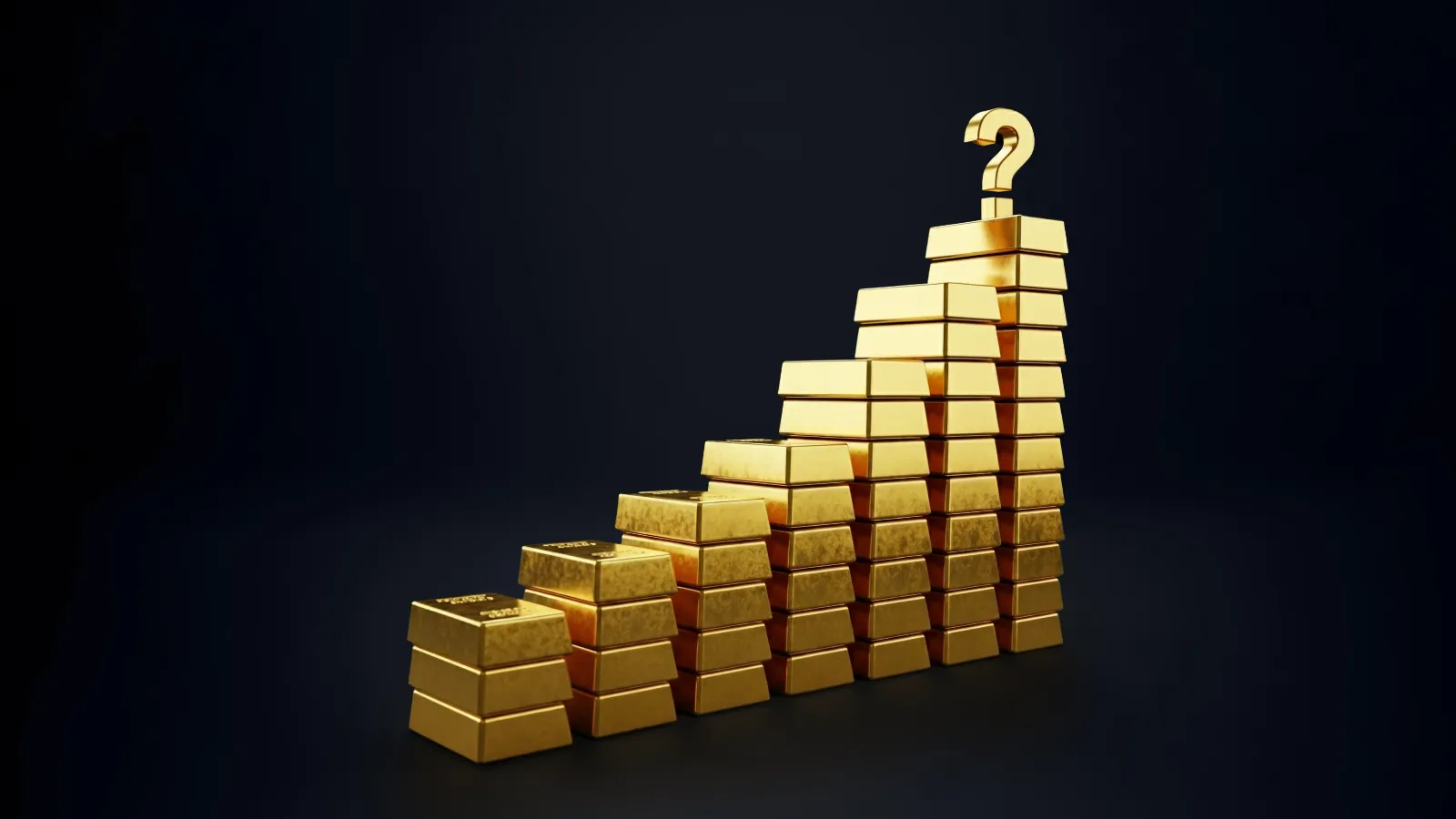
Gold’s record-breaking climb past $4,100 an ounce suggests that safe-haven demand isn’t done yet - but momentum may soon face its first real test. After a relentless rally driven by trade tensions, political shocks, and a flood of central bank buying, the question now is whether gold’s rally toward $4,500 represents the next phase of a structural bull market or the exhaustion point of a trend that’s run too far, too fast.
Key takeaways
- Gold has surged nearly 60% in 2025, breaking $4,200/oz for the first time ever amid renewed U.S.–China trade tensions and global risk aversion.
- The rally has coincided with strong equity performance, signalling a shift from fear-driven to liquidity-driven momentum.
- Central bank demand remains a cornerstone of the rally, alongside ETF inflows and investor hedging against inflation and currency debasement.
- Deutsche Bank warns that gold’s rally has “peaked in trendiness”, suggesting a possible consolidation phase.
- Despite stretched valuations, Goldman Sachs, Société Générale, and JPMorgan all forecast further upside - with targets as high as $5,000/oz.
- Easing geopolitical tensions or rising real yields could trigger short-term pullbacks, but long-term fundamentals remain supportive.
Gold’s record-breaking run and safe-haven surge
Gold’s climb through $4,100 marks a watershed moment for the precious metal, cementing its position as one of 2025’s best-performing assets. The latest leg higher was fuelled by renewed tensions between the U.S. and China, after both countries announced new port fees on shipping cargo - a move that shattered expectations of a trade thaw.
The news reignited memories of previous trade-war flare-ups and spurred a rush into traditional hedges like gold. The metal, which had reversed from an earlier all-time high near $4,180, quickly regained its footing around $4,090 before pushing back toward $4,125 during the European session. Futures even briefly topped $4,200, marking a historic milestone for bullion markets.
Gold keeps surging as geopolitical risk indexes slip
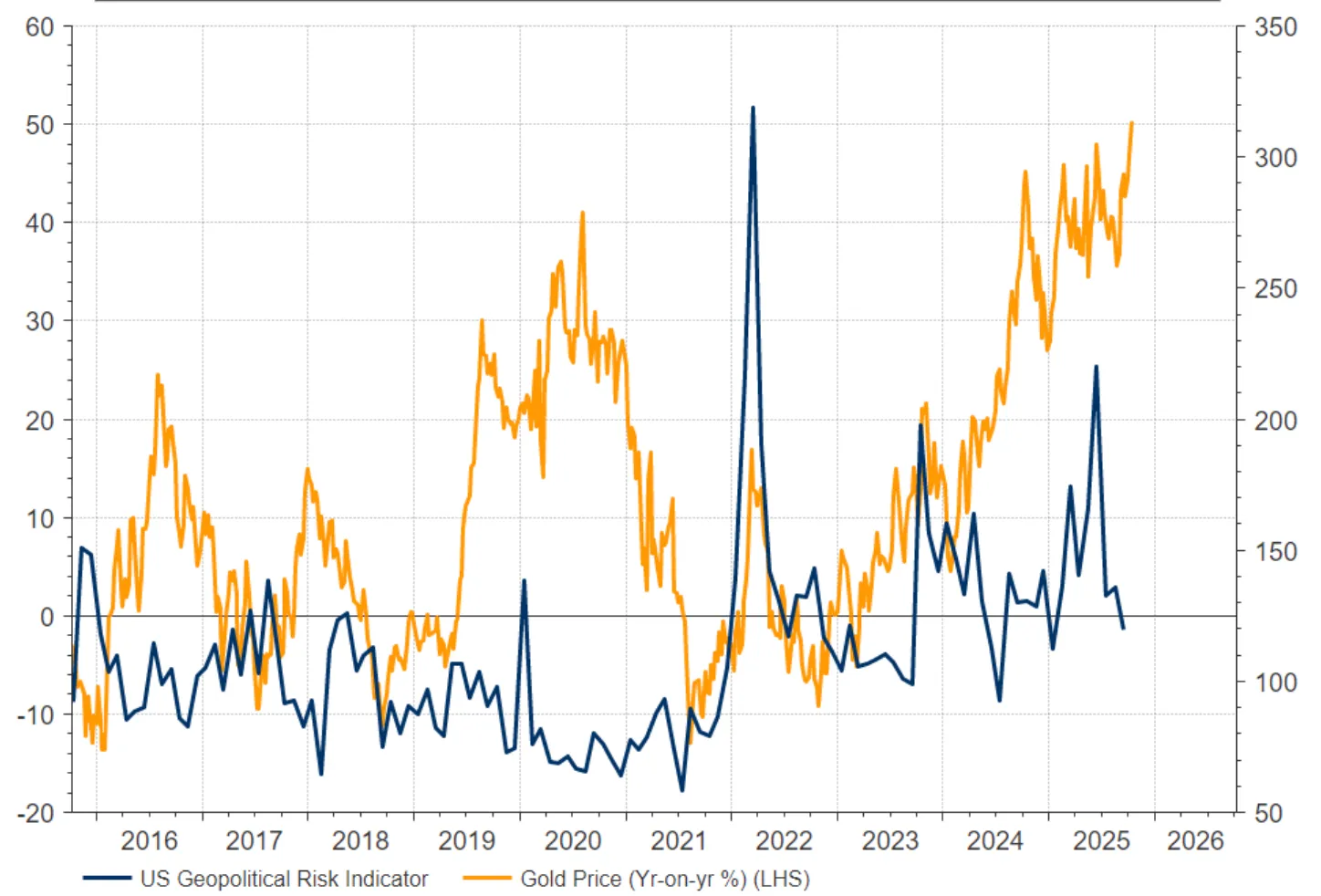
Beyond trade fears, the rally has been underpinned by political instability across key economies. France lost its prime minister just a day after his cabinet was appointed, the U.S. government entered an extended shutdown, and Japan moved to appoint a pro-stimulus prime minister calling for lower interest rates. Each event reinforced gold’s appeal as a global risk hedge - even as equities continued to rise, an anomaly that hints at something deeper than simple risk aversion.
Gold keeps rising as uncertainty EBBs
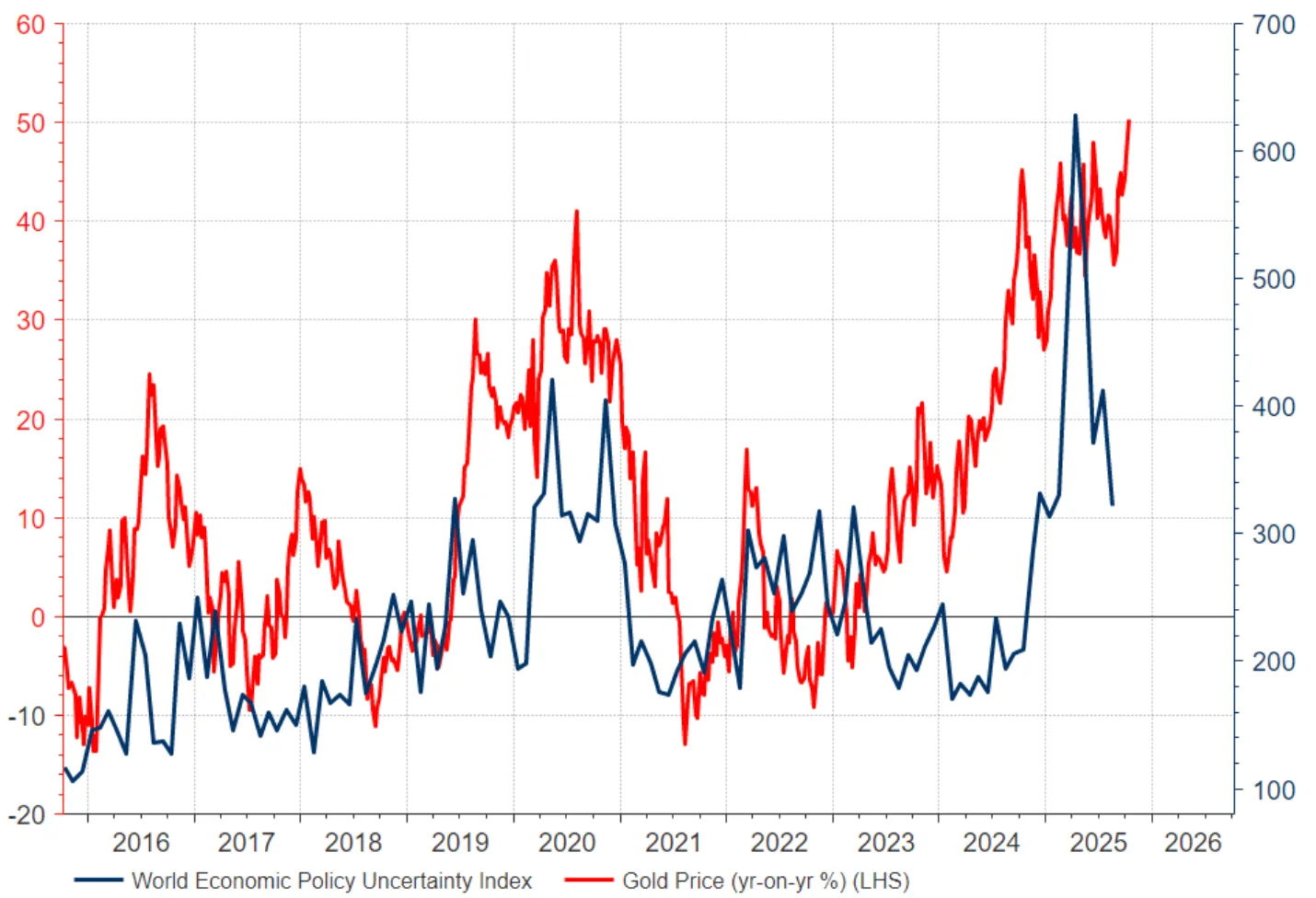
Gold-equity correlation: Why are both markets rising together
What makes this gold surge unusual is its parallel rise with global stocks. Normally, gold thrives when investors are fearful and equities are tumbling. But in 2025, both have risen together - a sign that liquidity and monetary policy, not panic, are driving flows.
The Federal Reserve’s renewed easing cycle has been central to this shift. Following a similar move in September, markets expect another 25 basis-point rate cut later this month.
Fed Chair Jerome Powell’s upcoming speech at the National Association for Business Economics is expected to acknowledge the challenge of limited data due to the ongoing government shutdown, but investors are already pricing in looser conditions ahead.
This lower-rate environment makes gold - a non-yielding asset - comparatively more attractive, particularly as real yields trend lower and inflation expectations edge higher. The combination of falling borrowing costs and political instability across multiple regions has amplified demand for physical gold, ETFs, and other gold-linked assets.
Safe-haven sentiment: Is this a new era or peak euphoria?
Major investment banks are split between conviction and caution.
- Goldman Sachs projects another 20% upside by the end of 2026, driven by enduring inflation and persistent geopolitical friction.
- Société Générale calls a rise to $5,000/oz “increasingly inevitable,” citing structural central bank demand.
- JPMorgan maintains gold as one of its “strongest conviction cross-asset views.”
However, this near-universal bullishness may itself be a warning. Deutsche Bank argues the rally may have “peaked in trendiness.” Their analysis shows that gold’s current trending phase has already lasted 29 days - far longer than the median 19-day uptrend seen in recent years. The bank doesn’t foresee an immediate correction but notes that investors are slowing purchases, signalling fatigue.
Meanwhile, HSBC cautions that if political or military tensions ease in 2026, gold prices could lose their upward momentum. This doesn’t necessarily imply a sharp reversal, but it does raise the prospect of a neutral or sideways phase as bullish sentiment cools.
Central bank gold buying: Disconnect from fundamentals
Gold’s acceleration has begun to outpace traditional drivers. Historically, falling real interest rates and rising geopolitical risk explain most of gold’s strength. But even as uncertainty indices have declined and the U.S. dollar has firmed, gold has refused to retrace.
JPMorgan attributes this to physical demand - especially from central banks and exchange-traded funds (ETFs). The ongoing de-dollarisation trend has prompted central banks, particularly in emerging markets, to diversify their reserves into gold. This “structural demand” creates a steady bid even when speculative interest wavers.
Still, this detachment raises a valid question: when gold rallies independent of risk and rates, does it still serve as a diversifier, or has it become part of the speculative mainstream?
Gold price prediction 2025: Policy signals and the next move
Recent market data suggests traders are growing sensitive to every shift in interest-rate expectations. As the market’s implied Fed terminal rate dropped to below 2.9% earlier this quarter, gold surged in response. But that terminal rate has ticked higher in recent weeks, supporting the dollar and hinting at potential short-term resistance for bullion.
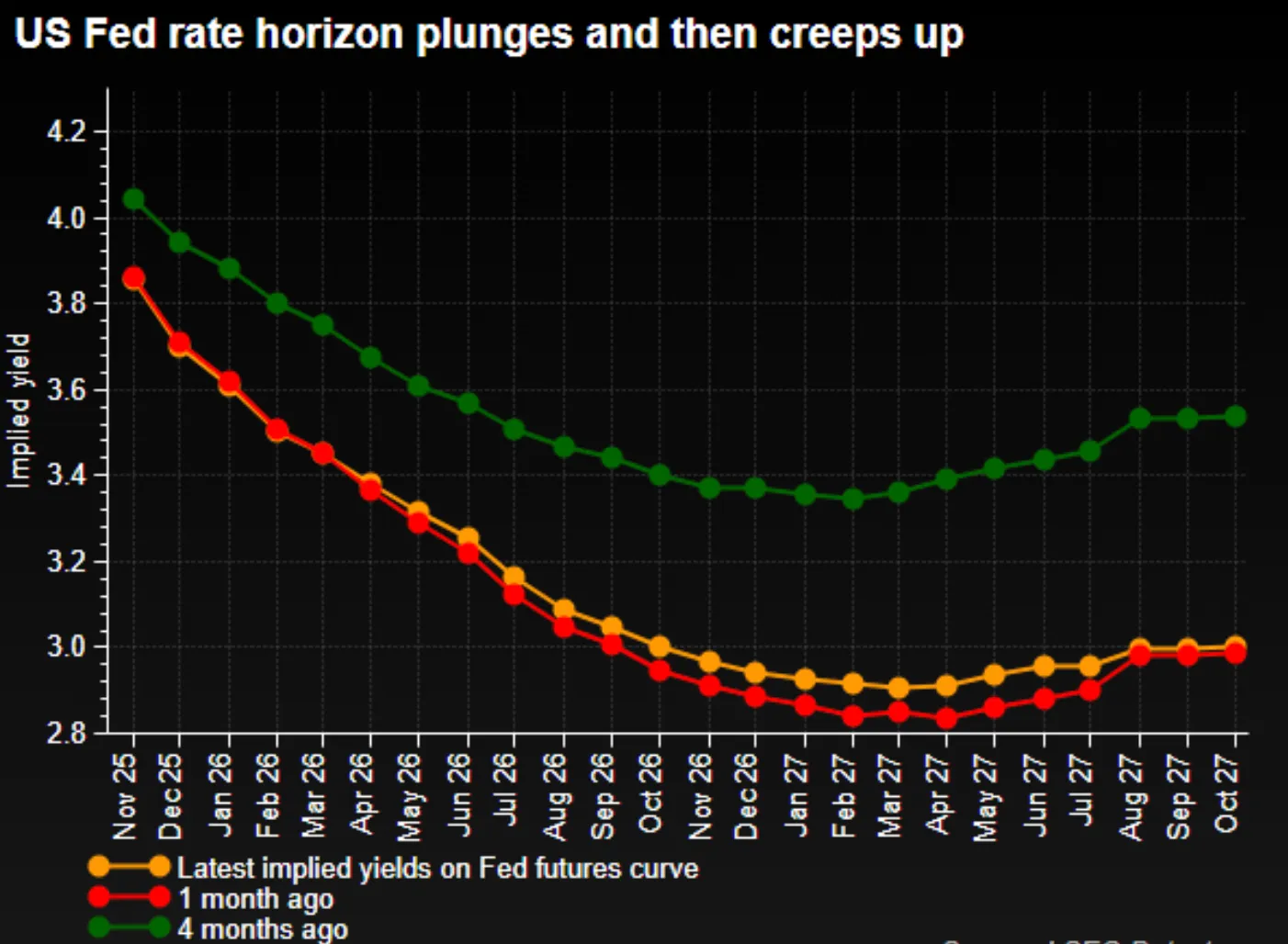
Simultaneously, Trump’s renewed tariff threats, China’s export curbs, and European political rifts continue to feed safe-haven demand. However, if those headlines fade, gold may pause before its next move higher.
Gold price technical analysis
Gold is currently trading just above $4,100, holding steady above key short-term support at $3,947. If prices maintain this base, bulls could attempt another run toward $4,250 and then $4,300. Failure to hold the $3,947 support could trigger a short-term pullback toward $3,626 and $3,310, levels that may attract renewed buying from central banks and long-term investors.
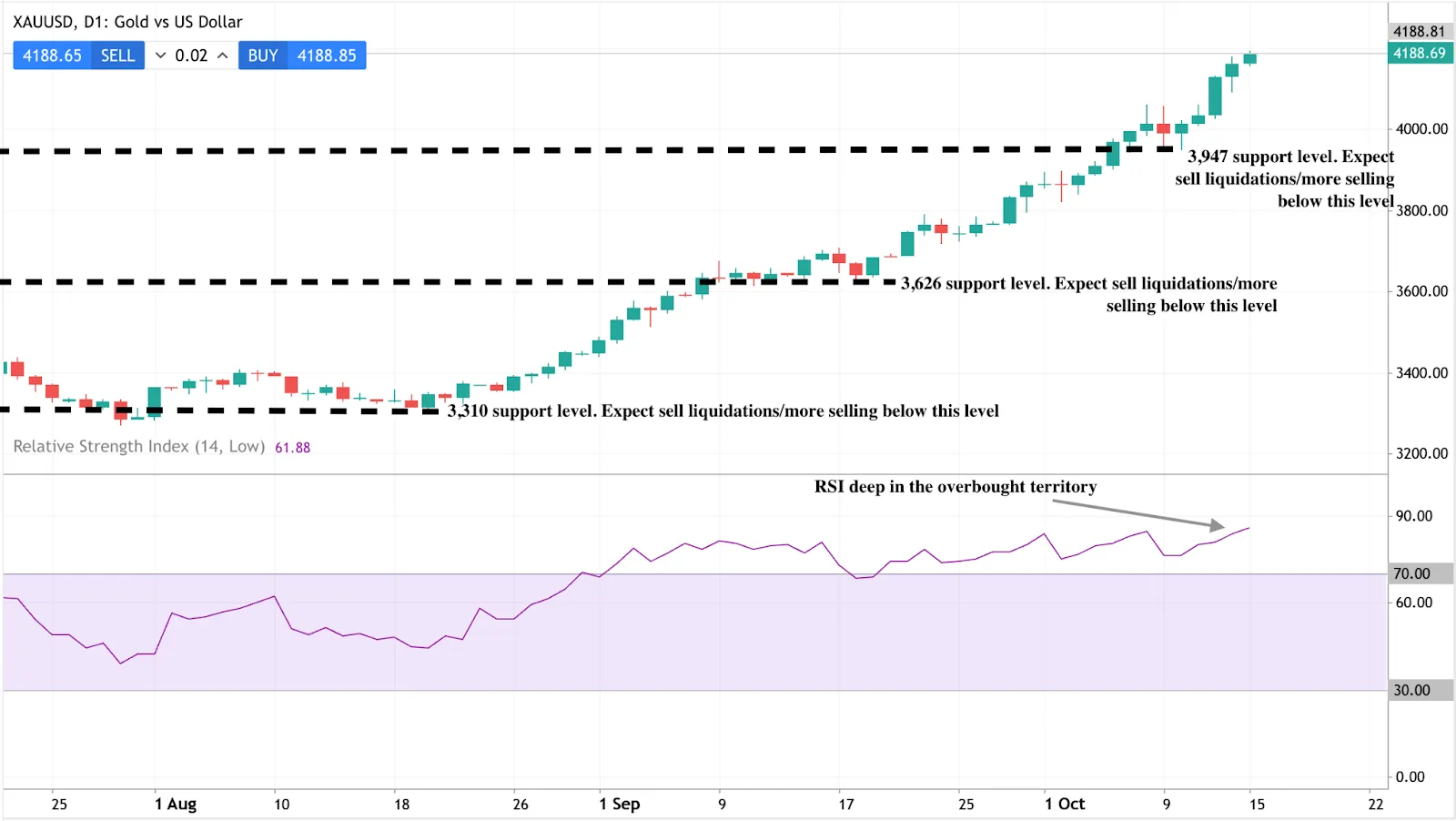
For traders monitoring price action, gold’s short-term volatility can be analysed through advanced charting tools on Deriv Trader, which offer dynamic indicators and depth-of-market views.
Trading gold on Deriv platforms
Gold has dominated global headlines and trading activity on Deriv’s platforms. During the recent price surge, trading volumes in gold CFDs on Deriv MT5 seem to have increased, reflecting heightened trader engagement.
Deriv MT5 remains the go-to platform for traders seeking precision and flexibility. It allows access to gold and other major commodities with advanced charting, multi-asset analysis, and fast execution speeds - critical features for navigating fast-moving markets.
Popular Deriv trader strategies
- Range trading: Exploiting gold’s intraday swings between $4,090 and $4,250 using disciplined stop levels and dynamic position sizing.
- Breakout trading: Entering around key resistance zones at $4,300 and $4,500 to capture potential post-news surges.
- Cross-asset hedging: Combining gold positions with currency pairs like USD/JPY or equity indices to manage risk across correlated markets.
Gold investment outlook
The 2025 gold rally represents both a defensive play and a confidence trade. It is defensive because it reflects fear of inflation, debt, and geopolitical fractures. It is also confident because investors are anticipating that policymakers will continue to err on the side of easy money.
If gold consolidates near current levels, that stability may attract new institutional inflows. Should political or policy shocks re-emerge, prices could accelerate toward $4,500 - validating the bullish forecasts. However, if global stability improves and yields rise, prices could drift lower into a $3,600–$3,900 trading range without undermining gold’s long-term appeal.
For now, the data suggests a pause, not a peak - a breather in what may be the early stages of a longer, more structural shift toward hard assets in a world of soft policy.
For readers tracking the broader commodities outlook, check out Deriv’s latest market pieces on oil’s $50 price floor scenario and crypto market trends - both relevant for understanding cross-asset sentiment shifts. You can also use Deriv’s trading calculator to model potential returns and risk exposure across multiple markets before taking a position.
The performance figures quoted are not a guarantee of future performance.



